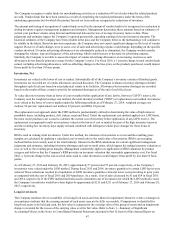Albertsons 2016 Annual Report Download - page 52
Download and view the complete annual report
Please find page 52 of the 2016 Albertsons annual report below. You can navigate through the pages in the report by either clicking on the pages listed below, or by using the keyword search tool below to find specific information within the annual report.50
Benefit Plans
The Company sponsors pension and other postretirement plans in various forms covering substantially all employees who meet
eligibility requirements. Pension benefits associated with these plans are generally based on each participant’s years of service,
compensation, and age at retirement or termination. The Company’s defined benefit pension plan, the SUPERVALU
Retirement Plan, and certain supplemental executive retirement plans were closed to new participants and service crediting
ended for all participants as of December 31, 2007.
While the Company believes the valuation methods used to determine the fair value of plan assets are appropriate and
consistent with other market participants, the use of different methodologies or assumptions to determine the fair value of
certain financial instruments could result in a different estimate of fair value at the reporting date.
The determination of the Company’s obligation and related expense for Company-sponsored pension and other postretirement
benefits is dependent, in part, on management’s selection of certain actuarial assumptions used in calculating these amounts.
These assumptions include, among other things, the discount rate, the expected long-term rate of return on plan assets and the
rates of increase in compensation and healthcare costs. During fiscal 2016, the Retirement Plans Experience Committee of the
Society of Actuaries ("RPEC") issued an update to Mortality Improvement Scale MP-2014, which was released in October
2014, named MP-2015. This updated scale was created using two additional years of historical data and the same RPEC 2014
model that was used to produce MP-2014. The Company used MP-2015 to calculate the fiscal 2016 projected benefit
obligation. Refer to Note 11—Benefit Plans in the Notes to Consolidated Financial Statements included in Part II, Item 8 of this
Annual Report on Form 10-K for additional discussion of actuarial assumptions used in determining pension and
postretirement health care liabilities and expenses.
The Company reviews and selects the discount rate to be used in connection with its pension and other postretirement
obligations annually. The discount rate reflects the current rate at which the associated liabilities could be effectively settled at
the end of the year. The Company sets its rate to reflect the yield of a portfolio of high quality, fixed-income debt instruments
that would produce cash flows sufficient in timing and amount to settle projected future benefits.
The Company’s expected long-term rate of return on plan assets assumption is determined based on the portfolio’s actual and
target composition, current market conditions, forward-looking return and risk assumptions by asset class, and historical long-
term investment performance. The assumed long-term rate of return on pension assets was 6.5 percent for fiscal 2016 and 6.5
percent and 7.0 percent for fiscal 2015. The 10-year rolling average annualized return for a portfolio of investments applied in a
manner consistent with our target allocations have generated average returns of approximately 8.2 percent based on returns
from 1990 to 2015. In accordance with Accounting Standards, actual results that differ from the Company’s assumptions are
accumulated and amortized over future periods and, therefore, affect expense and obligations in future periods.
Effective for fiscal 2017, the Company adopted an alternative approach for determining the interest and service cost
components of net periodic benefit cost for defined benefit pension and other postretirement benefit plans, the "full yield curve"
approach. Under this method, the discount rate assumption used in the interest and service cost components of net periodic
benefit cost was built through applying the specific spot rates along the yield curve used in the determination of the benefit
obligation described above, to the relevant projected future cash flows of the Company's pension and other postretirement
benefit plans. Prior to fiscal 2017, including for the current fiscal year 2016 being reported, the interest and service cost
components of pension expense were estimated using a single weighted-average discount rate derived from the yield curve
used to measure the projected benefit obligation at the beginning of the period.
The Company adopted the alternative approach to improve the correlation between projected benefit cash flows and the
corresponding yield curve spot rates and to provide a more precise measurement of interest and service costs. This change does
not affect the measurement of total benefit obligation. The Company has concluded that the application of the full yield curve
approach is a change in estimate and, accordingly, will recognize the effect prospectively beginning in fiscal 2017. The impact
of the change in estimate is an anticipated reduction of the interest and service cost components within net periodic benefit cost
in fiscal 2017 by approximately $22 for the defined benefit pension plans and less than $1 for postretirement benefit plans
compared to the prior year approach.
For fiscal 2017, each 25 basis point reduction in the discount rate would increase pension expense by approximately $8 and
each 25 basis point reduction in expected return on plan assets would increase pension expense by approximately $6. Similarly,
for postretirement benefits, a 100 basis point increase in the healthcare cost trend rate would increase the accumulated
postretirement benefit obligation as of the end of fiscal 2016 by approximately $3, and would increase service and interest cost
by less than $1. Conversely, a 100 basis point decrease in the healthcare cost trend rate would decrease the accumulated
postretirement benefit obligation as of the end of fiscal 2016 by approximately $3, and would decrease service and interest cost
by less than $1. Although the Company believes that its assumptions are appropriate, the actuarial assumptions may differ from
























